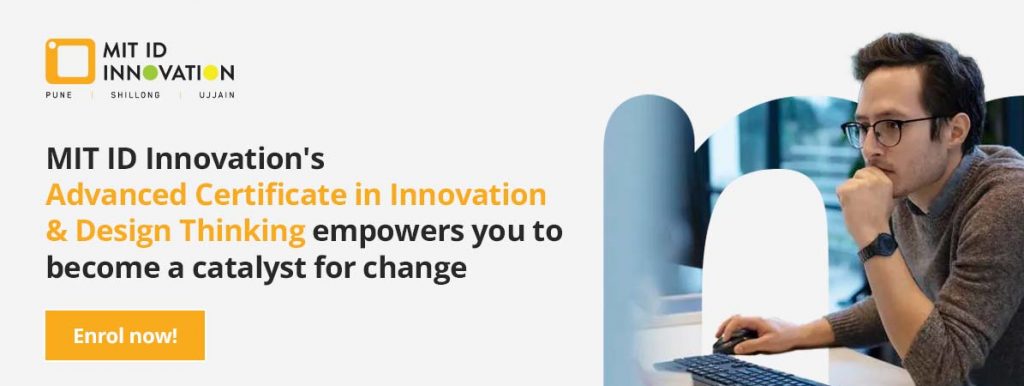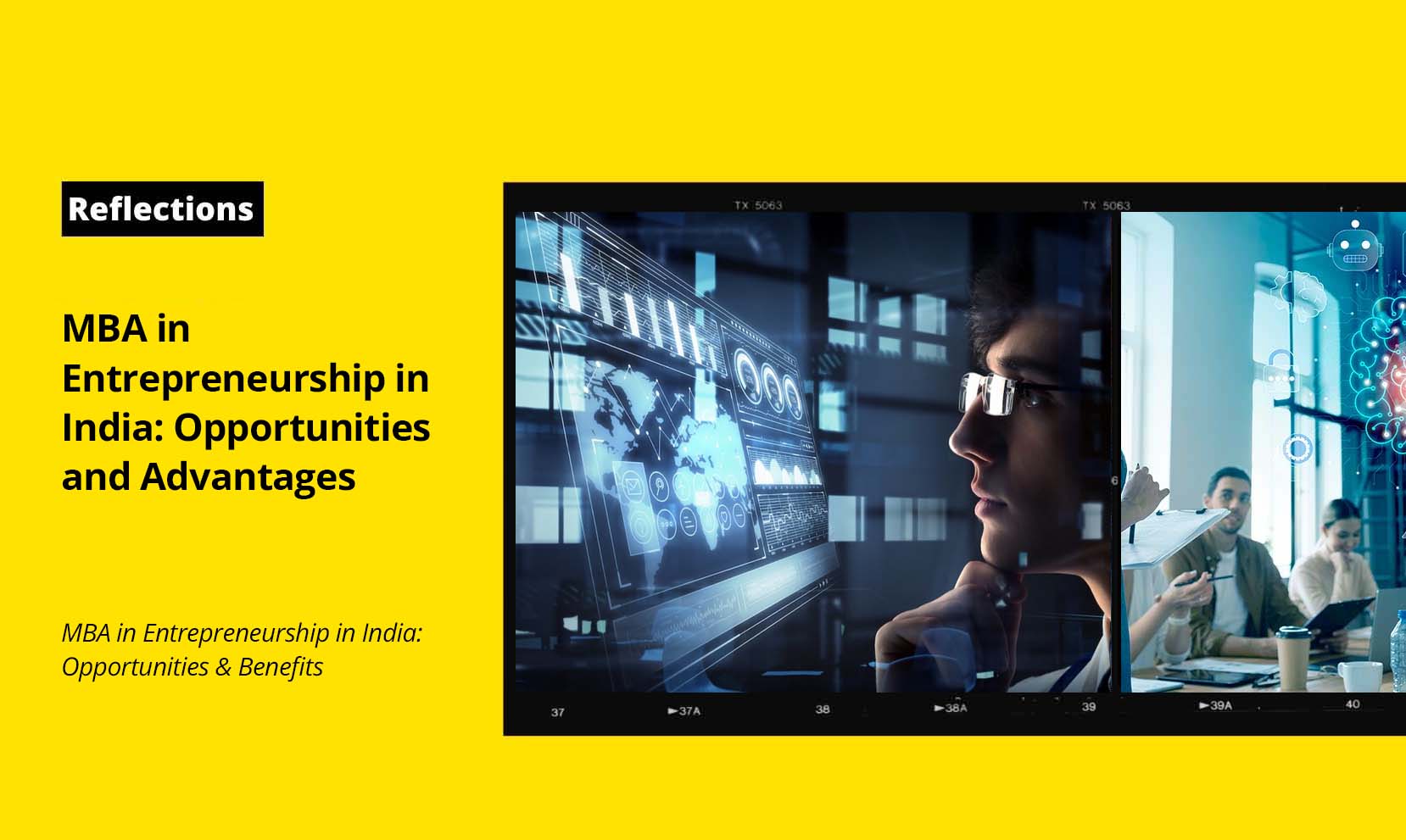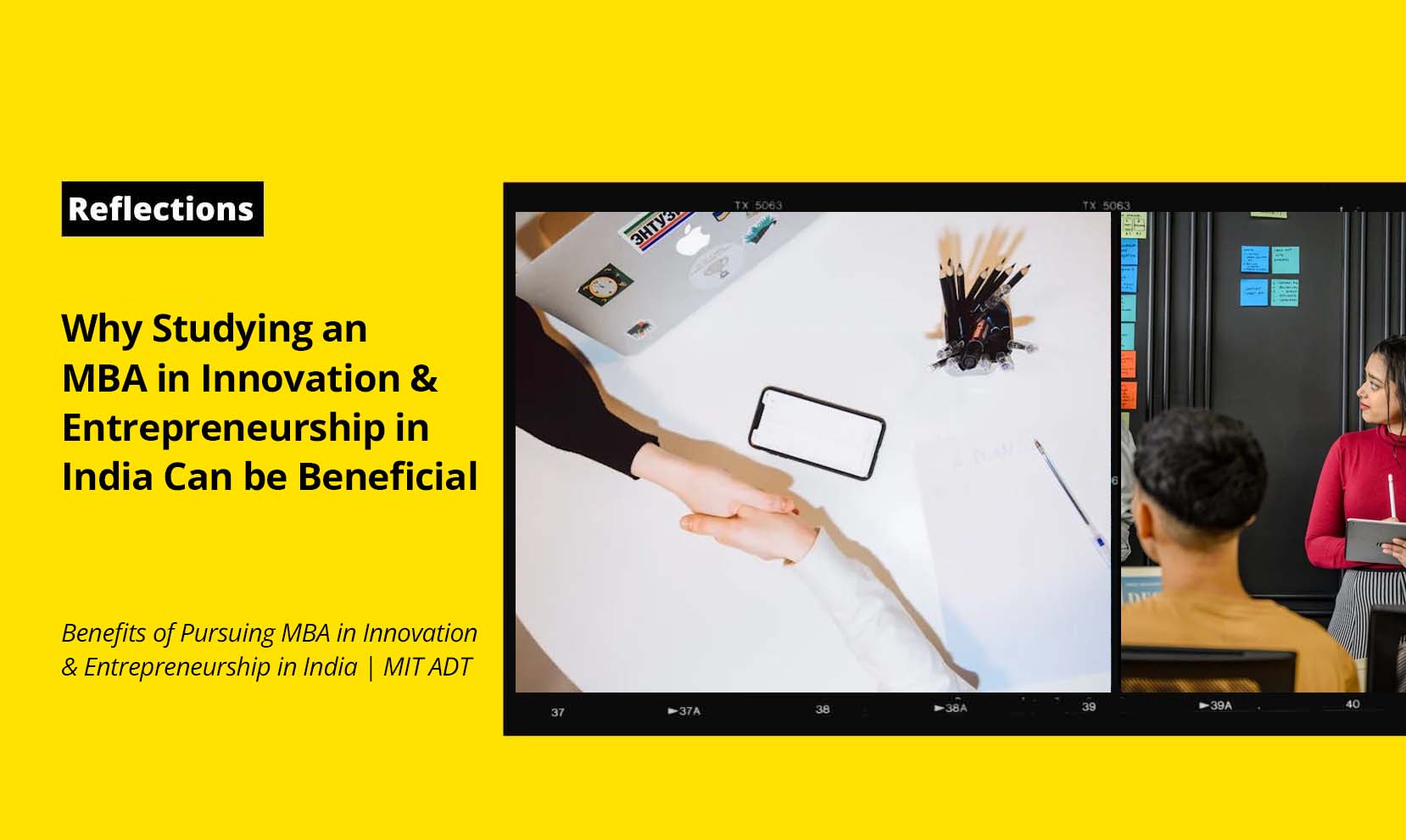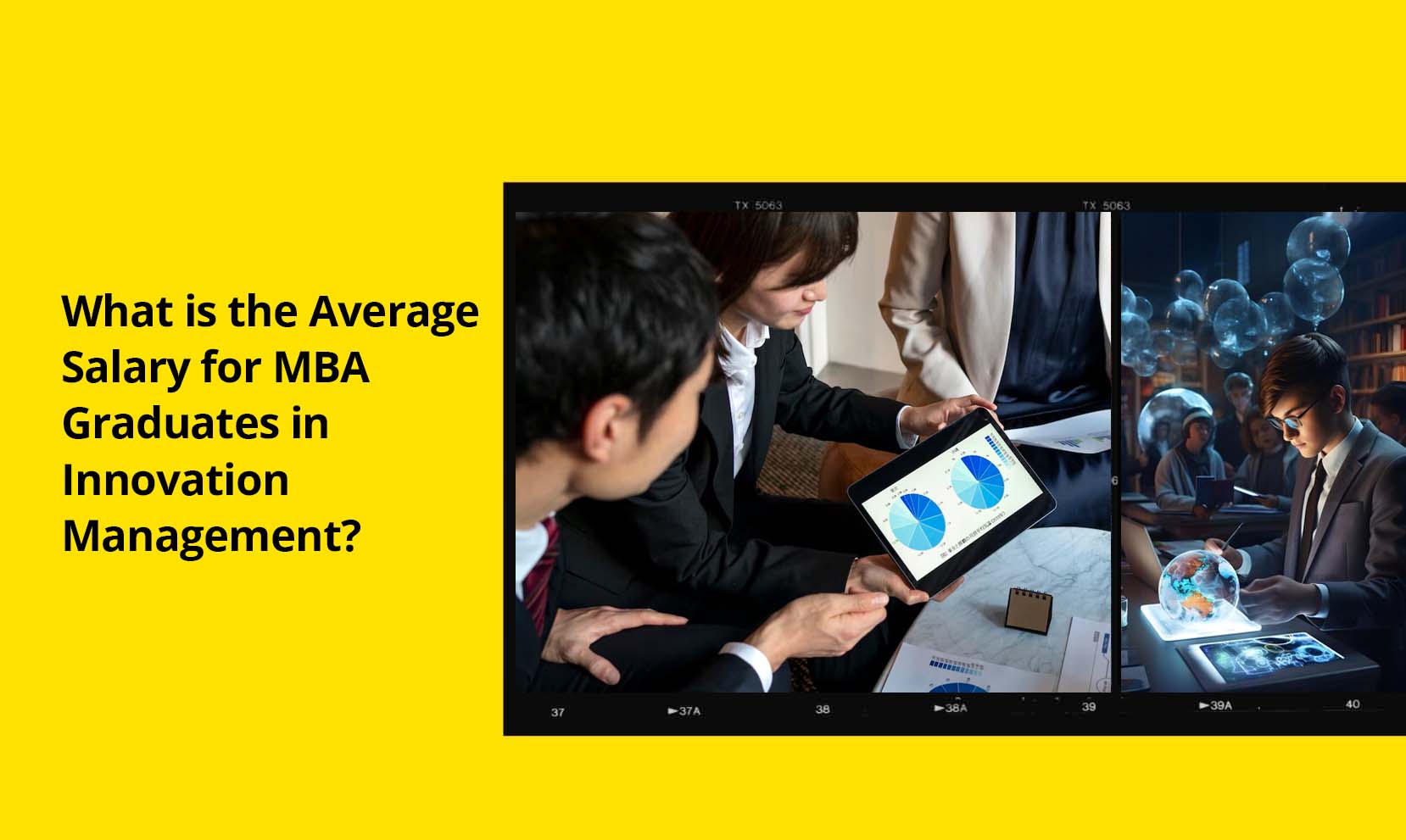How Innovation and Design Thinking Courses Foster Problem-Solving Skills
The present-day business landscape is intensely competitive and evolves rapidly, and organizations must continuously adapt and innovate to not fall behind the curve. Design thinking is one of the most efficient approaches to fostering growth and driving innovation in modern organizations – an anthropocentric, problem-solving methodology exercised with the foundations of collaboration, empathy, and collaboration. With the rapid advent of design thinking, courses such as the PG Diploma in Design Thinking and PG Diploma in Innovation have become a necessary part of the curriculum at leading design institutes.
The lack of innovation cannot drive forward design thinking. Design thinking aims for perfection in an iterative process by focusing on customers’ problems and providing efficient solutions to address challenging situations. With this double-ended approach, design thinking benefits both the customer and the organization.
Understanding Design Thinking
At its core, design thinking is a human-centric approach to tackling problems by empathizing with the users and gaining in-depth insights into their experiences. Rather than starting with preconceived notions, design thinking values open-mindedness and a willingness to challenge existing assumptions. It seeks to uncover unfulfilled needs and desires by putting aside organizational biases that often exist to create solutions that organically resonate with the end users.
The Different Stages of Design Thinking
According to recent market research, Design thinking is experiencing significant growth and will continue upward until 2026. Therefore, understanding the design thinking process has become more important than ever. Since Design thinking is a structured process, it generally consists of the five following design thinking stages:
- Empathize:
The foundation of Design thinking begins with empathizing with the end-users. Design thinkers immerse themselves in the users’ world by listening to their experiences, frustrations, and aspirations. Empathizing sets the fundamental framework for understanding the problem’s true source and establishes a strong connection with the people who will benefit from the eventual solution.
- Define:
The focus of design thinking shifts to defining the core problem that needs to be worked on after collecting insights from the users’ perspectives. This requires precise problem definition to ensure the framework’s next stages stay on track and align with the project’s end goal. Filtering the findings from the empathizing stage into vivid problem statements that can serve as a guiding marker throughout the process is also a part of the Defining process.
- Ideate:
The ideation phase involves the unleashing of creativity in the Design thinking structure. Design thinkers must brainstorm and generate many potential solutions to the problem. Quantity and diversity of ideas are valuable at this stage; these factors often lead to breakthrough concepts that might not have surfaced in a more constrained setting.
- Prototype:
The third phase, prototyping, brings concepts to life by progressing from disjointed ideas to tangible representations that materialize the findings from the previous three stages. Design thinkers must create rough prototypes of potential solutions to facilitate visualization and experience and analyze how emerging ideas might work. These quick and iterative prototypes allow rapid adjustments based on user and internal team feedback.
- Test:
The final stage of the five-fold process involves testing the prototypes with end users. Through this iterative and looping feedback and refinement process, design thinkers develop insights into what works and what doesn’t and implement that feedback to improve the solution further. Continuous testing is indispensable because it enables an adaptive approach and ensures that the outcome meets the users’ needs.
Innovation – The Catalyst of Design Thinking
At the heart of innovation lies the desire to address existing challenges and create meaningful change that impacts the end-user experience. Design thinking acts as a catalyst for innovation, inspiring a fresh and empathetic perspective toward problem-solving and placing the end-users at the centre of the process. With this approach, design thinking encourages a thorough understanding of the users’ needs, pain points, and aspirations. This intricate connection with the users fosters empathy-driven problem-solving and often leads to solutions that can make a real difference in the target audience’s lives.
Not just innovation, design thinking also nurtures creativity and imagination. Its strong inclination toward divergent thinking encourages exploring various possibilities, welcoming unconventional ideas and breakthrough concepts. Design thinking sets the stage for innovative thinking By breaking free from traditional molds, and sparks the creation of novel solutions that challenge the dominant conventional approach.

The Impact of Innovation and Design Thinking Courses
As we have already discussed, Design thinking is closely related to Innovation and acts as a catalyst for empowering change. Naturally, design thinking courses profoundly impact fostering problem-solving skills and empowering organizations to tackle complex issues with creativity and empathy. Now, let us discuss how these courses foster problem-solving skills.
- Cultivating a Growth Mindset
Innovation and design thinking courses are necessary to lay the foundations for a growth-focused mindset. Participants are encouraged to welcome challenges and view failures as learning opportunities instead of losses. The mindset shift that comes with such a course allows learners to approach problems with resilience and tenacity and promotes a willingness to explore multiple solutions and iterate on existing and new ideas until a viable answer is found.
- Empathy-Driven Problem Solving
Design thinking, in particular, emphasizes analyzing the needs and demands of end-users to understand their needs completely. By placing themselves in the users’ shoes, Design thinkers learn to identify and address pain points effectively and quickly. Empathy-driven problem-solving enables the creation of solutions that genuinely resonate with the target audience, leading to greater user satisfaction and increased loyalty.
- Enhancing Creativity and Ideation
Innovation and design thinking courses also boost creativity and ideation processes in the participants as they are encouraged to think outside the box and generate new and unique ideas, no matter how unconventional they may seem. The divergent thinking approach of design thinking allows for the exploration of innovative and groundbreaking solutions that might have otherwise been overlooked in a traditional approach to problem-solving.
- Structured Problem-Solving Methodology
Generally, innovation and design thinking courses provide a structured problem-solving methodology. The learners are introduced to a step-by-step process that guides them from understanding the problem to ideation, prototyping, and testing. The systematic approach in these courses prevents participants from feeling overwhelmed when faced with complex issues and helps with a focused and iterative problem-solving process.
- Collaboration and Cross-Disciplinary Skills
Innovation and design thinking courses often encourage collaborative work environments, and Participants from different backgrounds and disciplines are put together and challenged to solve problems collectively. The collaborative setting enhances cross-disciplinary skills and fosters diverse perspectives and ideas that pave the road for breakthrough innovations.
- Rapid Prototyping and Testing
Participants in these Design thinking courses are taught the importance of rapid prototyping and testing. Learners collect batches of early feedback and insights from potential users by creating quick, low-fidelity prototypes. The iterative and feedback-based approach to testing creates the space for continuous improvements and leads to the solution’s refinement until it effectively meets the users’ needs.
- Real-World Problem Solving
One of the significant advantages that innovation and design thinking courses provide is their focus on real-world problem-solving. For this purpose, participants are often presented with challenges faced by companies or communities. This hands-on experience equips learners with the skills needed to address complex and practical issues they may encounter in their personal and professional lives.
- Building Decision-Making Skills
Effective problem-solving always requires sound and competent decision-making. Innovation and design thinking courses teach participants to weigh different options, evaluate risks, and make informed decisions based on data and feedback. This skill is immensely valuable in personal and professional contexts, where decisions can significantly impact outcomes.
Innovative Implementations of Design Thinking
Design thinking is more than a buzzword in recent times; it has completely changed how businesses and organizations approach challenges across industries with its creative problem-solving approach. For instance, Airbnb’s success in the hospitality industry showcases design thinking’s effectiveness by understanding travellers’ needs, fostering trust, and creating a user-friendly platform that revolutionises accommodation booking worldwide. Similarly, IDEO’s implementation of design thinking in redesigning the shopping cart experience focused on empathizing with shoppers and led to an innovative modular cart system that personalizes the shopping experience and enhances the efficiency and satisfaction of the users.
Summing Up
Design thinking has emerged as a game-changing approach to problem-solving in the modern age, and the design thinking wave is sparking innovation and transforming industries across the globe. Its emphasis on empathy, collaboration, and creativity has resulted in remarkable success stories, such as Airbnb’s disruption of the hospitality industry and IDEO’s revolutionary shopping cart project.
Suppose you, too, want to become a trailblazer in innovation. In that case, MIT ID Innovation invites you to discover our comprehensive 1-year Innovation and Design Thinking course, where you will learn to tackle complex challenges confidently and skillfully. Take your expertise further with our 1-year Innovation and Design Thinking course, or explore specialized options like our PG Diploma in Design Thinking and PG Diploma in Innovation. Earn your prestigious Innovation and Design Thinking Certification and become a sought-after problem solver. MIT ID provides you with the key the unlock your creative potential, so join us today and participate in our programs with our vibrant community of thinkers and doers all over the globe.
Design thinking is a human-centric approach to problem-solving that puts empathy and creativity at the core of its philosophy. Unlike traditional methods that rely on predefined solutions, design thinking is implemented by understanding and analyzing the needs and experiences of end-users.
Answer: The role of innovation management is to oversee the process of developing, implementing, and sustaining innovative ideas, products, services, or processes inside an organization in order to promote growth, competitiveness, and adaptability.
Design thinking encourages a culture of continuous improvement and innovation in the workspace by promoting a mindset based on experimentation and growth. Diverse team members and stakeholders are actively involved, helping organizations dig into various perspectives.
There are various ways to learn design thinking. Many universities and institutions offer courses and workshops covering design thinking principles and applications. MIT Institute of Design’s 1-year Innovation and Design Thinking course is a good starting point for learning design thinking.
Answer:Yes, definitely! Many organizations offer certifications and programs in design thinking. For example, the MIT Institute of Design provides certification courses such as the Innovation and Design Thinking Certification program.



